child seat Peugeot 308 CC 2014 Owner's Manual
[x] Cancel search | Manufacturer: PEUGEOT, Model Year: 2014, Model line: 308 CC, Model: Peugeot 308 CC 2014Pages: 268, PDF Size: 15.33 MB
Page 5 of 268
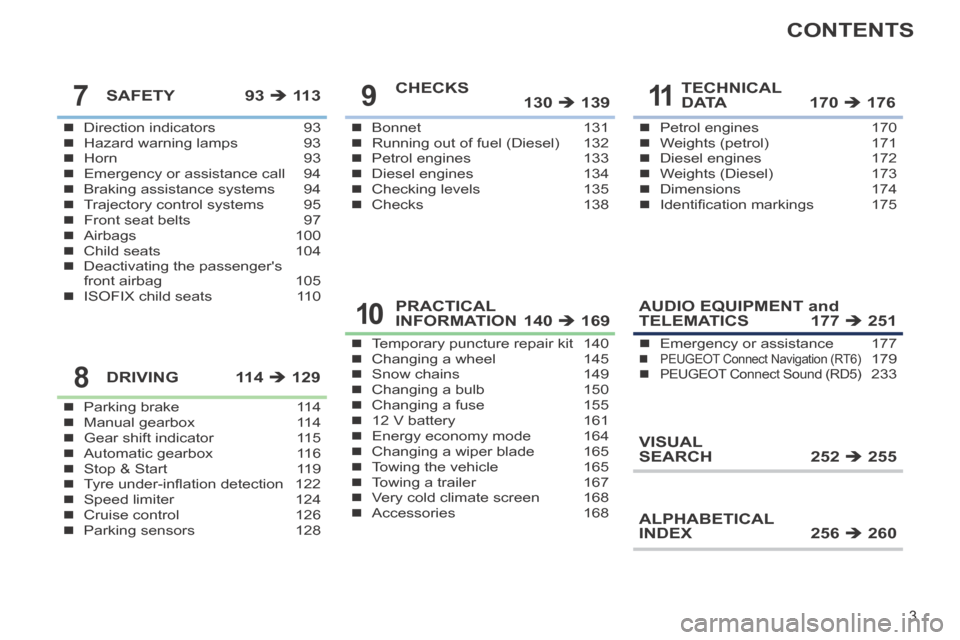
3
CONTENTS
Direction indicators 93Hazard warning lamps 93Horn 93Emergency or assistance call 94Braking assistance systems 94Trajectory control systems 95Front seat belts 97Airbags 100Child seats 104Deactivating the passenger's front airbag 105ISOFIX child seats 110
SAFETY 93 11 3
Parking brake 114Manual gearbox 114Gear shift indicator 115Automatic gearbox 116Stop & Start 119Tyre under-infl ation detection 122Speed limiter 124Cruise control 126Parking sensors 128
DRIVING 114 129
Bonnet 131Running out of fuel (Diesel) 132Petrol engines 133Diesel engines 134Checking levels 135Checks 138
CHECKS 130 139
Temporary puncture repair kit 140Changing a wheel 145Snow chains 149Changing a bulb 150Changing a fuse 15512 V battery 161Energy economy mode 164Changing a wiper blade 165Towing the vehicle 165Towing a trailer 167Very cold climate screen 168Accessories 168
PRACTICAL INFORMATION 140 169
Petrol engines 170Weights (petrol) 171Diesel engines 172Weights (Diesel) 173Dimensions 174Identifi cation markings 175
TECHNICAL D ATA 170 D ATA 170 D ATA 176
AUDIO EQUIPMENT and TELEMATICS 177 251
VISUAL SEARCH 252 255
ALPHABETICAL INDEX 256 260
Emergency or assistance 177PEUGEOT Connect Navigation (RT6)PEUGEOT Connect Navigation (RT6)PEUGEOT 179PEUGEOT Connect Sound (RD5)PEUGEOT Connect Sound (RD5)PEUGEOT 233
7
8
9
10
11
Page 18 of 268
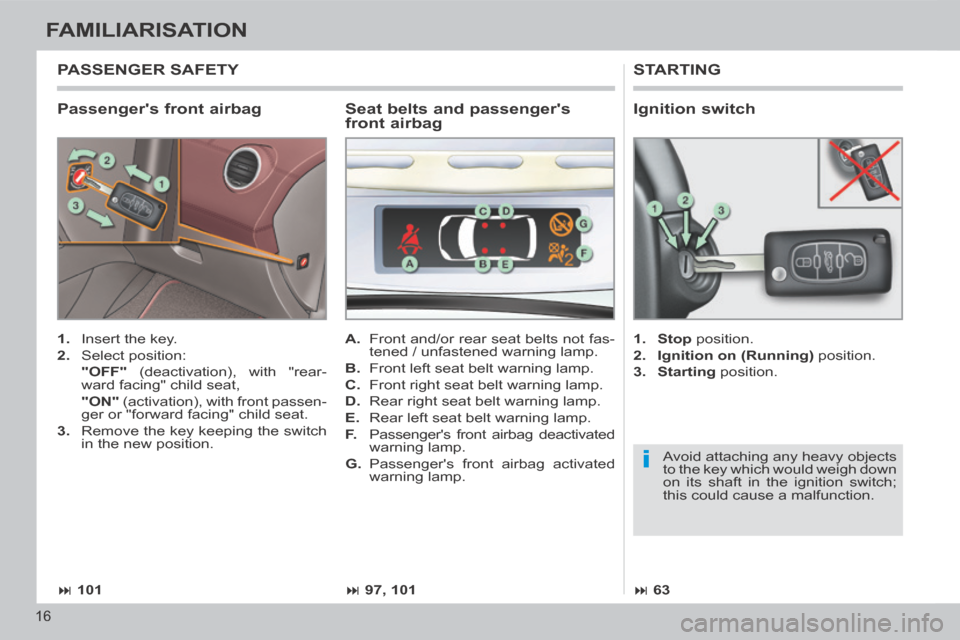
i
101 97, 101 63
16
FAMILIARISATION
Passenger's front airbag
STARTING
1. Insert the key.
2. Select position:
"OFF" (deactivation), with "rear-
ward facing" child seat,
"ON" (activation), with front passen-
ger or "forward facing" child seat.
3. Remove the key keeping the switch in the new position. 1. Stop position.
2. Ignition on (Running) position.
3. Starting position.
A. Front and/or rear seat belts not fas-
tened / unfastened warning lamp.
B. Front left seat belt warning lamp.
C. Front right seat belt warning lamp.
D. Rear right seat belt warning lamp.
E. Rear left seat belt warning lamp.
F. Passenger's front airbag deactivated
warning lamp.
G. Passenger's front airbag activated warning lamp.
Seat belts and passenger's
front airbag
PASSENGER SAFETY
Ignition switch
Avoid attaching any heavy objects
to the key which would weigh down
on its shaft in the ignition switch;
this could cause a malfunction.
Page 31 of 268
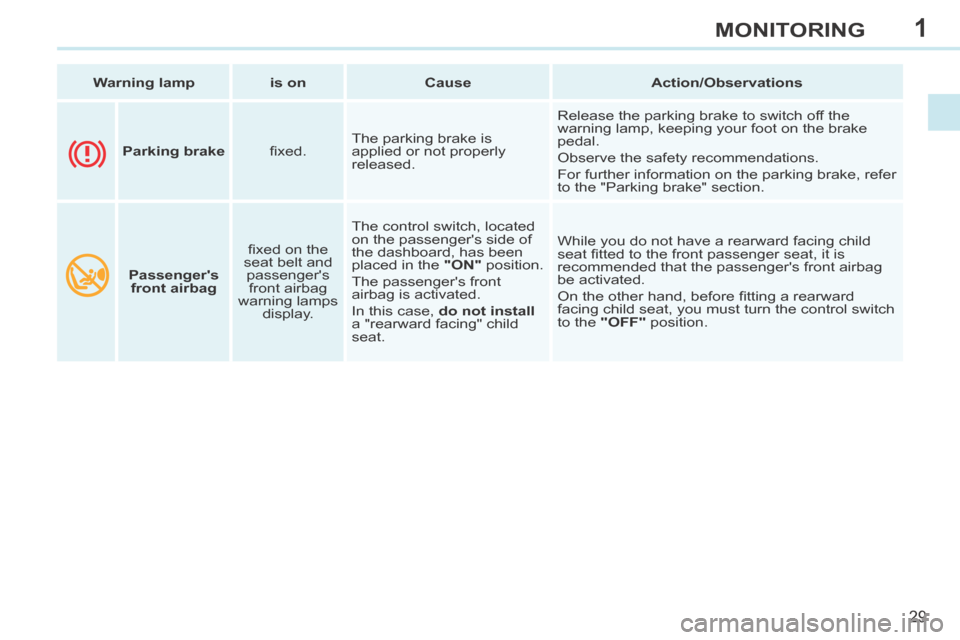
1
29
MONITORING
Warning lamp is on Cause Action/Observations
Passenger's
front airbag fi xed on the
seat belt and passenger's front airbag
warning lamps display. The control switch, located
on the passenger's side of
the dashboard, has been
placed in the
"ON" position.
The passenger's front
airbag is activated.
In this case, do not install
a "rearward facing" child
seat. While you do not have a rearward facing child
seat fi tted to the front passenger seat, it is
recommended that the passenger's front airbag
be activated.
On the other hand, before fi tting a rearward
facing child seat, you must turn the control switch
to the
"OFF" position.
Parking brake fi xed. The parking brake is
applied or not properly
released. Release the parking brake to switch off the
warning lamp, keeping your foot on the brake
pedal.
Observe the safety recommendations.
For further information on the parking brake, refer
to the "Parking brake" section.
Page 32 of 268
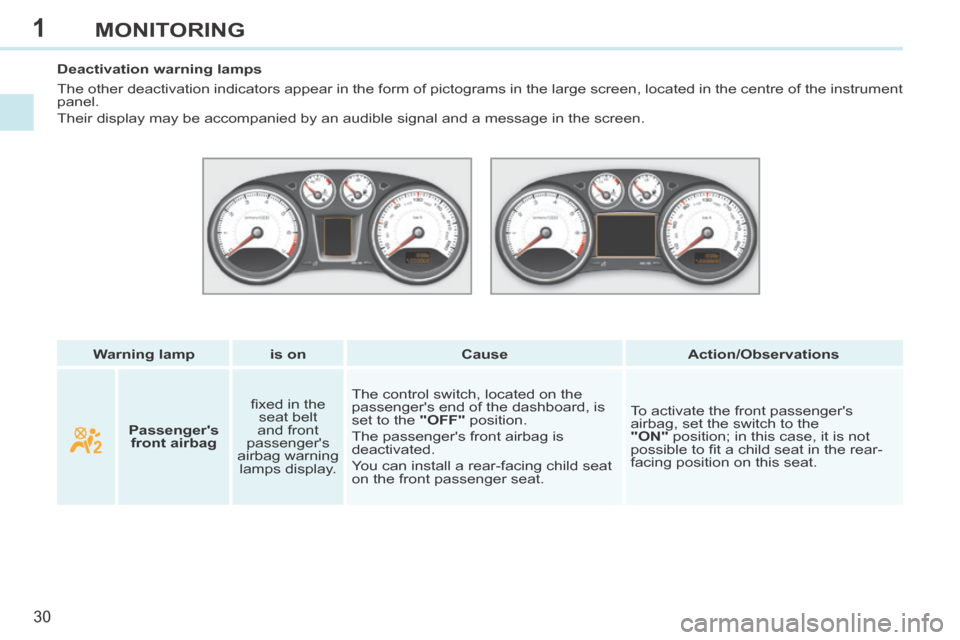
1
30
MONITORING
Warning lamp is on Cause Action/Observations
Deactivation warning lamps
The other deactivation indicators appear in the form of pictograms in th\
e large screen, located in the centre of the instrument
panel.
Their display may be accompanied by an audible signal and a message in t\
he screen.
Passenger's
front airbag fi xed in the
seat belt
and front
passenger's
airbag warning lamps display. The control switch, located on the
passenger's end of the dashboard, is
set to the
"OFF" position.
The passenger's front airbag is
deactivated.
You can install a rear-facing child seat
on the front passenger seat. To activate the front passenger's
airbag, set the switch to the
"ON" position; in this case, it is not
possible to fi t a child seat in the rear-
facing position on this seat.
Page 58 of 268
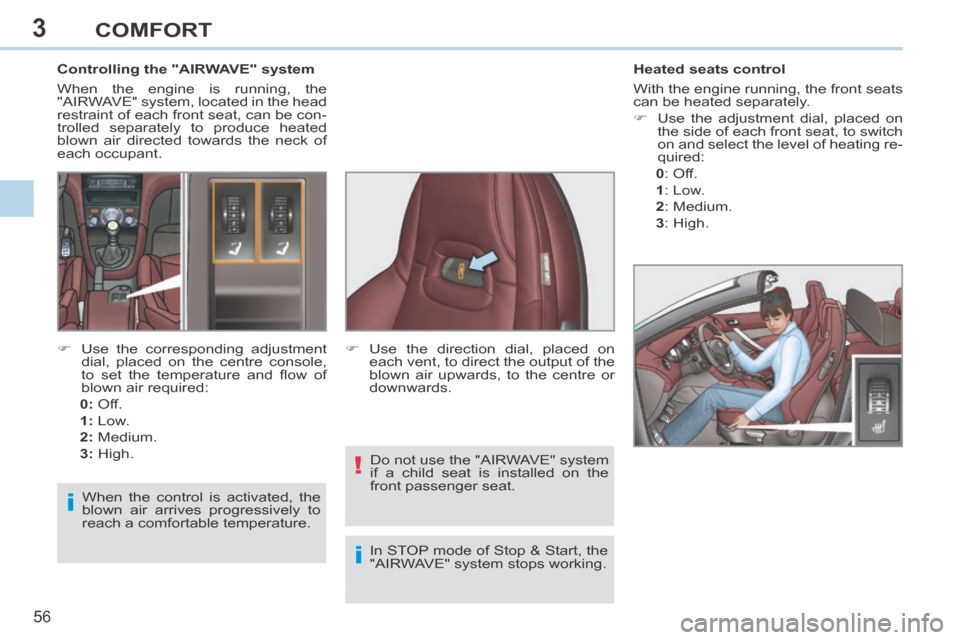
3
i!
i
56
COMFORT
Controlling the "AIRWAVE" system
When the engine is running, the
"AIRWAVE" system, located in the head
restraint of each front seat, can be con-
trolled separately to produce heated
blown air directed towards the neck of
each occupant. Heated seats control
With the engine running, the front seats
can be heated separately.
Use the adjustment dial, placed on
the side of each front seat, to switch
on and select the level of heating re-
quired:
0 : Off.
1 : Low.
2 : Medium.
3 : High.
Use the corresponding adjustment dial, placed on the centre console,
to set the temperature and fl ow of
blown air required:
0: Off.
1: Low.
2: Medium.
3: High. Use the direction dial, placed on
each vent, to direct the output of the
blown air upwards, to the centre or
downwards.
When the control is activated, the
blown air arrives progressively to
reach a comfortable temperature. Do not use the "AIRWAVE" system
if a child seat is installed on the
front passenger seat.
In STOP mode of Stop & Start, the
"AIRWAVE" system stops working.
Page 101 of 268
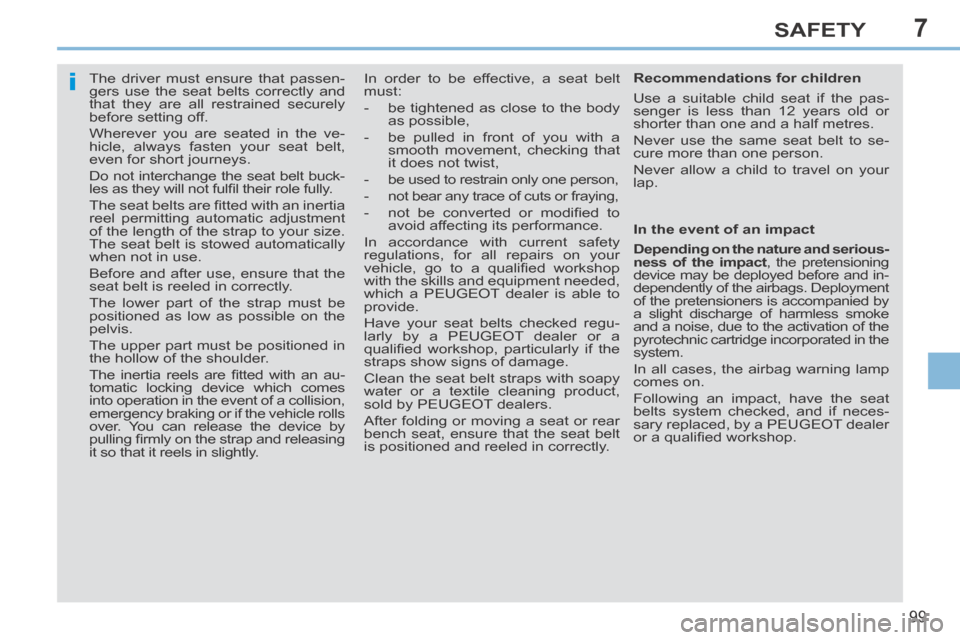
7
i
99
SAFETY
The driver must ensure that passen-
gers use the seat belts correctly and
that they are all restrained securely
before setting off.
Wherever you are seated in the ve-
hicle, always fasten your seat belt,
even for short journeys.
Do not interchange the seat belt buck-
les as they will not fulfi l their role fully.
The seat belts are fi tted with an inertia
reel permitting automatic adjustment
of the length of the strap to your size.
The seat belt is stowed automatically
when not in use.
Before and after use, ensure that the
seat belt is reeled in correctly.
The lower part of the strap must be
positioned as low as possible on the
pelvis.
The upper part must be positioned in
the hollow of the shoulder.
The inertia reels are fi tted with an au-
tomatic locking device which comes
into operation in the event of a collision,
emergency braking or if the vehicle rolls
over. You can release the device by
pulling fi rmly on the strap and releasing
it so that it reels in slightly. In order to be effective, a seat belt
must:
- be tightened as close to the body
as possible,
- be pulled in front of you with a smooth movement, checking that
it does not twist,
- be used to restrain only one person,
- not bear any trace of cuts or fraying,
- not be converted or modifi ed to avoid affecting its performance.
In accordance with current safety
regulations, for all repairs on your
vehicle, go to a qualifi ed workshop
with the skills and equipment needed,
which a PEUGEOT dealer is able to
provide.
Have your seat belts checked regu-
larly by a PEUGEOT dealer or a
qualifi ed workshop, particularly if the
straps show signs of damage.
Clean the seat belt straps with soapy
water or a textile cleaning product,
sold by PEUGEOT dealers.
After folding or moving a seat or rear
bench seat, ensure that the seat belt
is positioned and reeled in correctly. Recommendations for children
Use a suitable child seat if the pas-
senger is less than 12 years old or
shorter than one and a half metres.
Never use the same seat belt to se-
cure more than one person.
Never allow a child to travel on your
lap.
In the event of an impact
Depending on the nature and serious-
ness of the impact , the pretensioning
device may be deployed before and in-
dependently of the airbags. Deployment
of the pretensioners is accompanied by
a slight discharge of harmless smoke
and a noise, due to the activation of the
pyrotechnic cartridge incorporated in the
system.
In all cases, the airbag warning lamp
comes on.
Following an impact, have the seat
belts system checked, and if neces-
sary replaced, by a PEUGEOT dealer
or a qualifi ed workshop.
Page 103 of 268
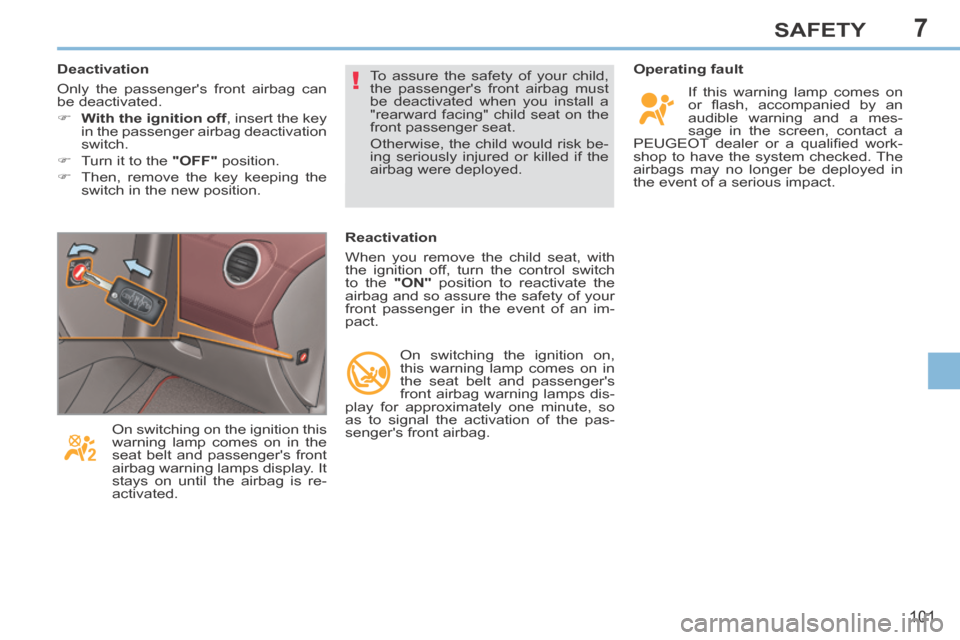
7
!
101
SAFETY
Operating fault If this warning lamp comes on
or fl ash, accompanied by an
audible warning and a mes-
sage in the screen, contact a
PEUGEOT dealer or a qualifi ed work-
shop to have the system checked. The
airbags may no longer be deployed in
the event of a serious impact.
Reactivation
When you remove the child seat, with
the ignition off, turn the control switch
to the "ON" position to reactivate the
airbag and so assure the safety of your
front passenger in the event of an im-
pact.
On switching the ignition on,
this warning lamp comes on in
the seat belt and passenger's
front airbag warning lamps dis-
play for approximately one minute, so
as to signal the activation of the pas-
senger's front airbag. To assure the safety of your child,
the passenger's front airbag must
be deactivated when you install a
"rearward facing" child seat on the
front passenger seat.
Otherwise, the child would risk be-
ing seriously injured or killed if the
airbag were deployed.
On switching on the ignition this
warning lamp comes on in the
seat belt and passenger's front
airbag warning lamps display. It
stays on until the airbag is re-
activated.
Deactivation
Only the passenger's front airbag can
be deactivated.
With the ignition off , insert the key
in the passenger airbag deactivation
switch.
Turn it to the "OFF" position.
Then, remove the key keeping the switch in the new position.
Page 105 of 268
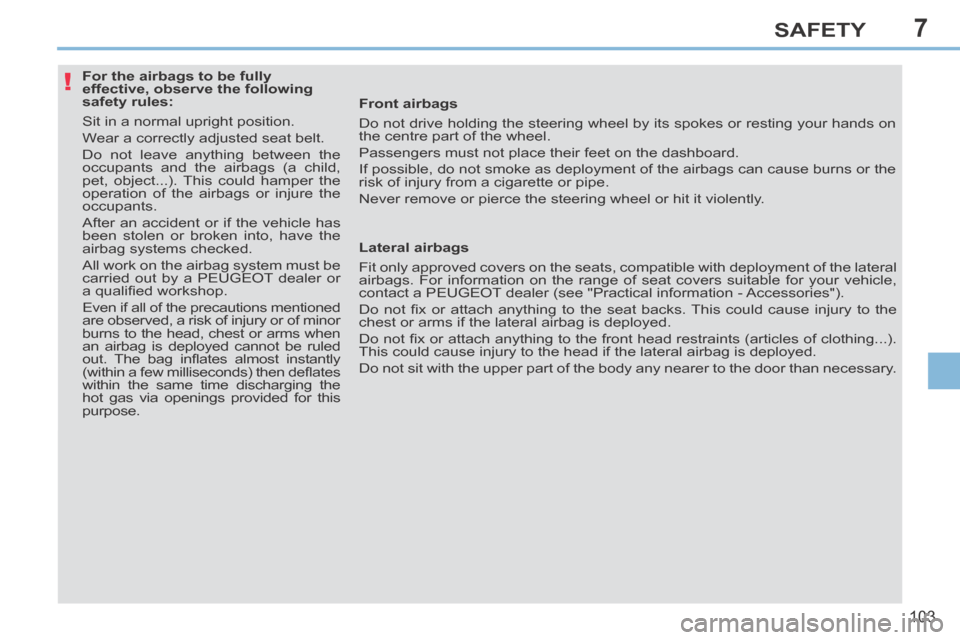
7
!
103
SAFETY
For the airbags to be fully
effective, observe the following
safety rules:
Sit in a normal upright position.
Wear a correctly adjusted seat belt.
Do not leave anything between the
occupants and the airbags (a child,
pet, object...). This could hamper the
operation of the airbags or injure the
occupants.
After an accident or if the vehicle has
been stolen or broken into, have the
airbag systems checked.
All work on the airbag system must be
carried out by a PEUGEOT dealer or
a qualifi ed workshop.
Even if all of the precautions mentioned
are observed, a risk of injury or of minor
burns to the head, chest or arms when
an airbag is deployed cannot be ruled
out. The bag infl ates almost instantly
(within a few milliseconds) then defl ates
within the same time discharging the
hot gas via openings provided for this
purpose. Front airbags
Do not drive holding the steering wheel by its spokes or resting your ha\
nds on
the centre part of the wheel.
Passengers must not place their feet on the dashboard.
If possible, do not smoke as deployment of the airbags can cause burns or the
risk of injury from a cigarette or pipe.
Never remove or pierce the steering wheel or hit it violently.
Lateral airbags
Fit only approved covers on the seats, compatible with deployment of the\
lateral
airbags. For information on the range of seat covers suitable for your vehicle,
contact a PEUGEOT dealer (see "Practical information - Accessories").
Do not fi x or attach anything to the seat backs. This could cause injury to the
chest or arms if the lateral airbag is deployed.
Do not fi x or attach anything to the front head restraints (articles of clothing...).
This could cause injury to the head if the lateral airbag is deployed.
Do not sit with the upper part of the body any nearer to the door than necessary.
Page 106 of 268
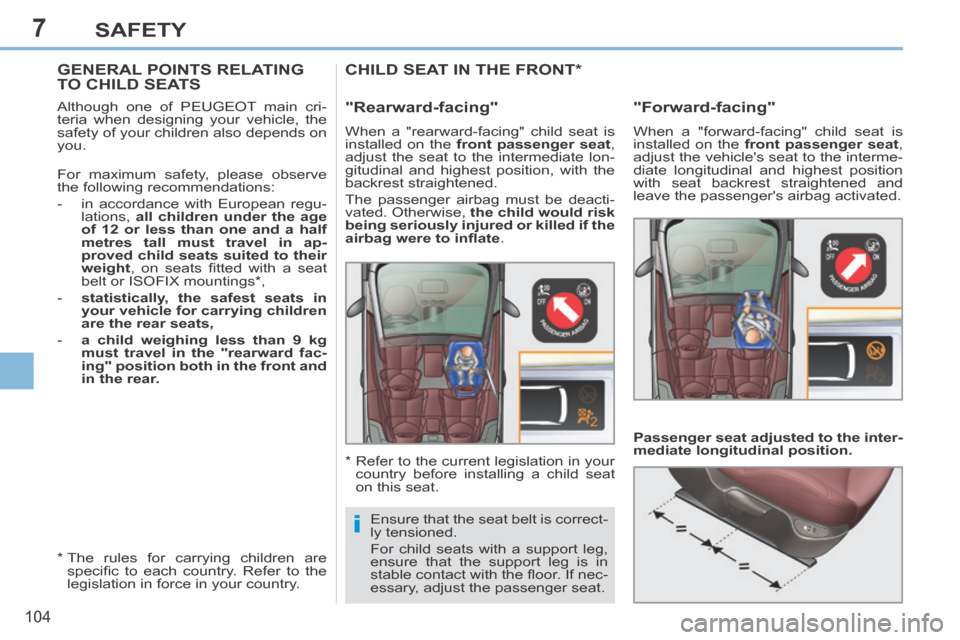
7
i
104
SAFETY
GENERAL POINTS RELATING TO CHILD SEATS
Although one of PEUGEOT main cri-
teria when designing your vehicle, the
safety of your children also depends on
you.
For maximum safety, please observe
the following recommendations:
- in accordance with European regu-lations, all children under the age
of 12 or less than one and a half
metres tall must travel in ap-
proved child seats suited to their
weight , on seats fi tted with a seat
belt or ISOFIX mountings * ,
- statistically, the safest seats in your vehicle for carrying children
are the rear seats,
- a child weighing less than 9 kg must travel in the "rearward fac-
ing" position both in the front and
in the rear.
* The rules for carrying children are specifi c to each country. Refer to the
legislation in force in your country.
CHILD SEAT IN THE FRONT *
"Forward-facing"
"Rearward-facing"
When a "rearward-facing" child seat is
installed on the front passenger seat ,
adjust the seat to the intermediate lon-
gitudinal and highest position, with the
backrest straightened.
The passenger airbag must be deacti-
vated. Otherwise, the child would risk
being seriously injured or killed if the
airbag were to infl ate . When a "forward-facing" child seat is
installed on the
front passenger seat ,
adjust the vehicle's seat to the interme-
diate longitudinal and highest position
with seat backrest straightened and
leave the passenger's airbag activated.
* Refer to the current legislation in your country before installing a child seat
on this seat.
Ensure that the seat belt is correct-
ly tensioned.
For child seats with a support leg,
ensure that the support leg is in
stable contact with the fl oor. If nec-
essary, adjust the passenger seat. Passenger seat adjusted to the inter-
mediate longitudinal position.
Page 107 of 268
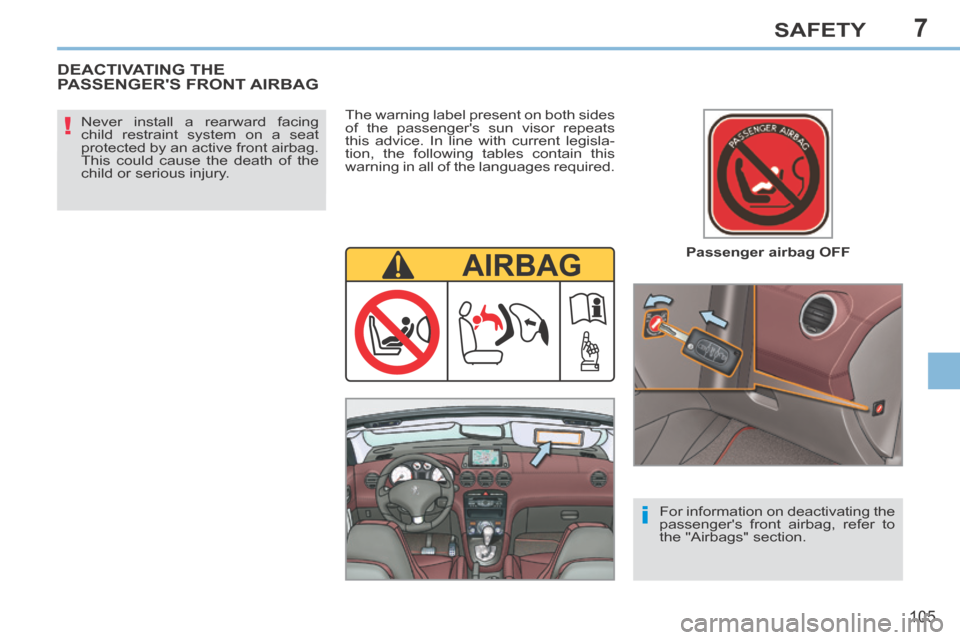
7
!
i
105
SAFETY
Passenger airbag OFF
Never install a rearward facing
child restraint system on a seat
protected by an active front airbag.
This could cause the death of the
child or serious injury.
DEACTIVATING THE PASSENGER'S FRONT AIRBAG
The warning label present on both sides
of the passenger's sun visor repeats
this advice. In line with current legisla-
tion, the following tables contain this
warning in all of the languages required.
For information on deactivating the
passenger's front airbag, refer to
the "Airbags" section.